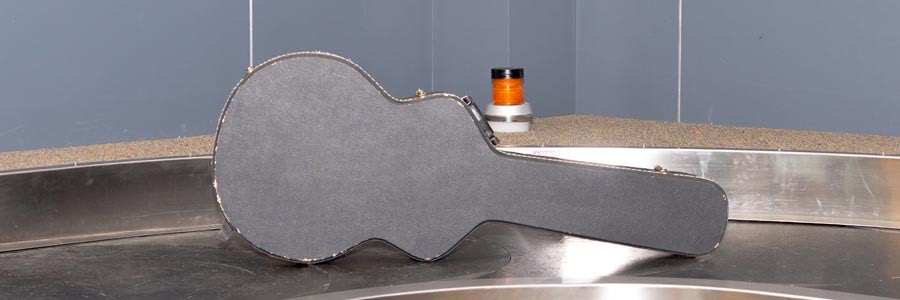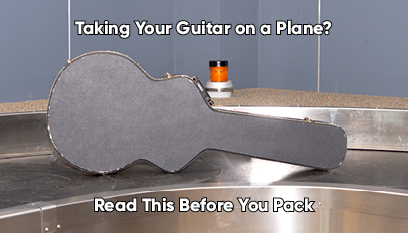
My wife and I recently flew from the East Coast to Hawaii, and we spent a considerable amount of time hanging out in airports and going through security. That got me wondering: How do musicians take their guitar rigs on planes?
The short answer is that you can bring guitar gear on commercial flights in either carry-on or checked luggage. Carrying it on the plane is the safest option, though.
So what’s the long answer? Before we get to that, it’s worth asking whether you really need to bring your guitar rig with you. Is it possible to leave some, or all, of your equipment at home and borrow or rent the equipment you need when you get there? If so, I’d recommend doing that instead of flying with your gear.
Even touring musicians do not necessarily need to travel with every element of their usual rig. For example, you may be able to ditch the full pedal board for the trip, and bring only a few pedals that you really need for the show you’re going to play. Maybe your set won’t sound precisely the same as usual, but scaling back could be worth it if it makes the trip easier.
Another alternative to flying with your full rig is to bring gear that wasn’t very expensive and doesn’t hold much sentimental value. That way, you won’t be heartbroken if it gets damaged, lost, or stolen along the way. If you have to travel with really high-end equipment, make sure it’s insured! Or have it shipped it to your destination instead.
Assuming that you do need to fly with your prized gear, here are a few tips to save time and frustration.
Book Nonstop Flights When You Can
When you are planning your trip, consider booking direct flights so you don’t have to worry about the possibility of your checked baggage missing a connection. Fewer stops mean fewer opportunities for your luggage to get lost and fewer opportunities for your gear to be (mis)handled. Finally, if you’re carrying your gear on the plane, a direct flight will save you the hassle of lugging heavy stuff around extra airports.
Check Airline Policy
Different airlines have different policies about baggage, and the associated fees can really add up. Research those policies before you book to make sure you’re not surprised later. Be especially wary of budget airlines, which often try to make up for low base fares with lots of annoying fees.
To comparison-shop effectively, you will need to know the weight and dimensions of your gear, along with anything else you are bringing on the trip. You can’t bring a guitar as a carry-on if you are also carrying on a backpack, a purse, and a duffel bag stuffed with clothes.
Choose a Sturdy Guitar Case
Airplane baggage takes a lot of abuse, even without turbulence. Leave the soft gig case at home, and pack your guitar in the most durable case you have – even if you are planning to carry it on the plane. That way, if the flight is full and your gear needs to be gate-checked, you’ll be prepared.
Gate-checking gear is a popular tactic, as it means your stuff will be last on the plane and therefore less likely to get trampled under all the other baggage. Gate-checked bags also skip the trip around the conveyor belt at the destination. If you have to check your guitar, that’s the best way to do it.
You don’t need a fancy custom-molded case to fly with your guitar. Just don’t use the case that your guitar came with unless you verify that it is certified for air travel.
I used to think that the only options out there for flight cases were hundreds and hundreds of dollars, but I’ve recently found the TSA series of cases from Gator (available from Amazon). These cases fit multiple styles of guitars and feature TSA-approved locks in addition to being sturdy enough for air travel.
There are also flight cases for amps and pedal boards if you absolutely have to fly with them, but bear in mind weight limits on checked bags — especially for amps. The cost of flying with properly protected amps and pedal boards will give you a reason to seriously investigate rented backline gear when you arrive at your destination.
Take the Guitar in Pieces
This strategy applies only to guitars with bolt-on necks (sorry, Les Paul players).
If you’re a competent guitar tech, and ONLY if you’re a competent guitar tech, you can actually take the guitar apart for travel. Once the neck has been removed from the body you can pack both parts in your regular luggage with your clothes, and you’re good to go! This may sound a bit extreme, but I have a friend who has done this multiple times when he has flown to SXSW and it has worked out perfectly for him.
If you do use this method, just remember that you won’t have a case for that guitar, so you may want to pack a gig bag to use at your destination. That’s probably the only situation in which flying with a gig bag isn’t a terrible idea.
Do You Really Need to De-tune the Guitar For Flight?
You may have heard that it’s important to de-tune guitars (make the strings more slack than normal) before taking them on planes. Allegedly, this will prevent damage to the neck from changing air pressure and temperature conditions. However, guitars are designed to function with the strings under appropriate tension. Unless you also adjust the truss rod, you could risk damaging the neck over time if you make a habit of de-tuning for air travel.
Beloved pets survive just fine in the cargo compartments of planes, so it’s not like the air in there is dangerous. Your guitar is far more likely to be damaged from bouncing around inside a poorly fitting case than by anything to do with the air pressure in the plane. So skip the de-tuning and pack your guitar appropriately, or your guitar could end up needing a lot more than a set-up when you get back!
Pack Carefully
Once you have your guitar in its sturdy case, fill any gaps (especially under the neck) with bubble wrap, T-shirts, socks, etc. This will help keep the guitar from moving inside the case as it gets jostled in transit. Don’t leave anything in the case besides the guitar itself and the padding around it, as small items can fly around and scratch the guitar’s finish. Now is a great time to get that silica gel packet out of your guitar case if it’s still there!
Guitar tools and small containers of liquid, like polish or cleaner, should be kept in your checked bags, as they might cause problems when you go through security. That brings me to the next point…
Prepare for Questions
Bringing expensive equipment and electronics through airport security can be nerve-wracking. Plenty of musicians manage to carry gear around the world with no questions asked, but some passengers do get stopped. TSA staff may know nothing about guitars, so some of your gear may look suspicious to them. You may be asked to plug in your pedals to show that they really work (and are not decoys hiding an explosive device). Pickups and cables can look potentially dangerous in an X-ray machine, so you may have to explain those as well.
Some guitarists have found it handy to bring a guitar magazine with them, to help show that their equipment is harmless. To be extra-prepared, print out some information about the pedals you have – especially if they have eyebrow-raising names like Dirty Bomb or Landmine. You can even pack them in their original boxes if you still have them.
While it might seem like a great idea to lock your guitar case for air travel as one more way to keep your guitar safe, you should only do so if your case’s lock is TSA-approved — and most aren’t. If you lock your case for flight and it’s not TSA-approved, there is a very good chance that the lock will be broken by the time you retrieve the guitar at baggage claim.
If your case can be locked with a padlock, all you have to do is buy a TSA-approved luggage lock like one of these available from Amazon and you’re good to go.
If you’d rather not spend a few dollars on a TSA lock, then I’d suggest using some duct tape or better yet, gaffer tape to secure the latches and keep them from inadvertently springing open as they bump into other baggage in transit.
Before you leave for the airport, it’s always a good idea to double-check the information on your luggage tags to confirm it is still correct. You wouldn’t want someone trying to contact you about your lost guitar using an old email address or phone number.
Try to Board First
Thanks to federal rules that took effect in March 2015, guitars, violins, and other “small” musical instruments must be treated the same as any other carry-on baggage. As long as there is overhead space available for your guitar at the time you board, you must be allowed to keep it with you. Flight attendants can no longer make you check your instrument to make more room for suitcases.
So if you really want to make sure your guitar won’t be checked, try to be among the first passengers to board the plane. There are many possible ways to do that, such as joining the airline’s rewards program, applying for the airline’s credit card, or reserving a seat toward the back of the plane. Some airlines, like Southwest, have open seating based on check-in order, so you can often get into the first boarding group just by checking in online 24 hours before your flight. Other airlines actually let you pay a little extra for the privilege of priority boarding.
This strategy may be moot if you are flying on a tiny commuter plane that doesn’t have much overhead space to begin with, but it’s worth a shot. If all else fails, you can ask the flight attendants if you can put the guitar in the closet they use for garment bags. You never know, they might let you!
After Landing
If you did decide to check your equipment, head directly to baggage claim once your plane lands. You will want to collect your items as soon as possible so they doesn’t get banged up by extra trips on the conveyor belts, or worse, stolen. Examine the contents right away so that you can notify the airline of any issues before you leave the airport.
Finally, Don’t be a Jerk
Whenever you are interacting with airport staff or flight attendants (or really, anyone in general!), make an effort to be polite. It’s easy to get snippy when tired and frustrated, but people are much more likely to be helpful if you’re nice.
Safe travels!


